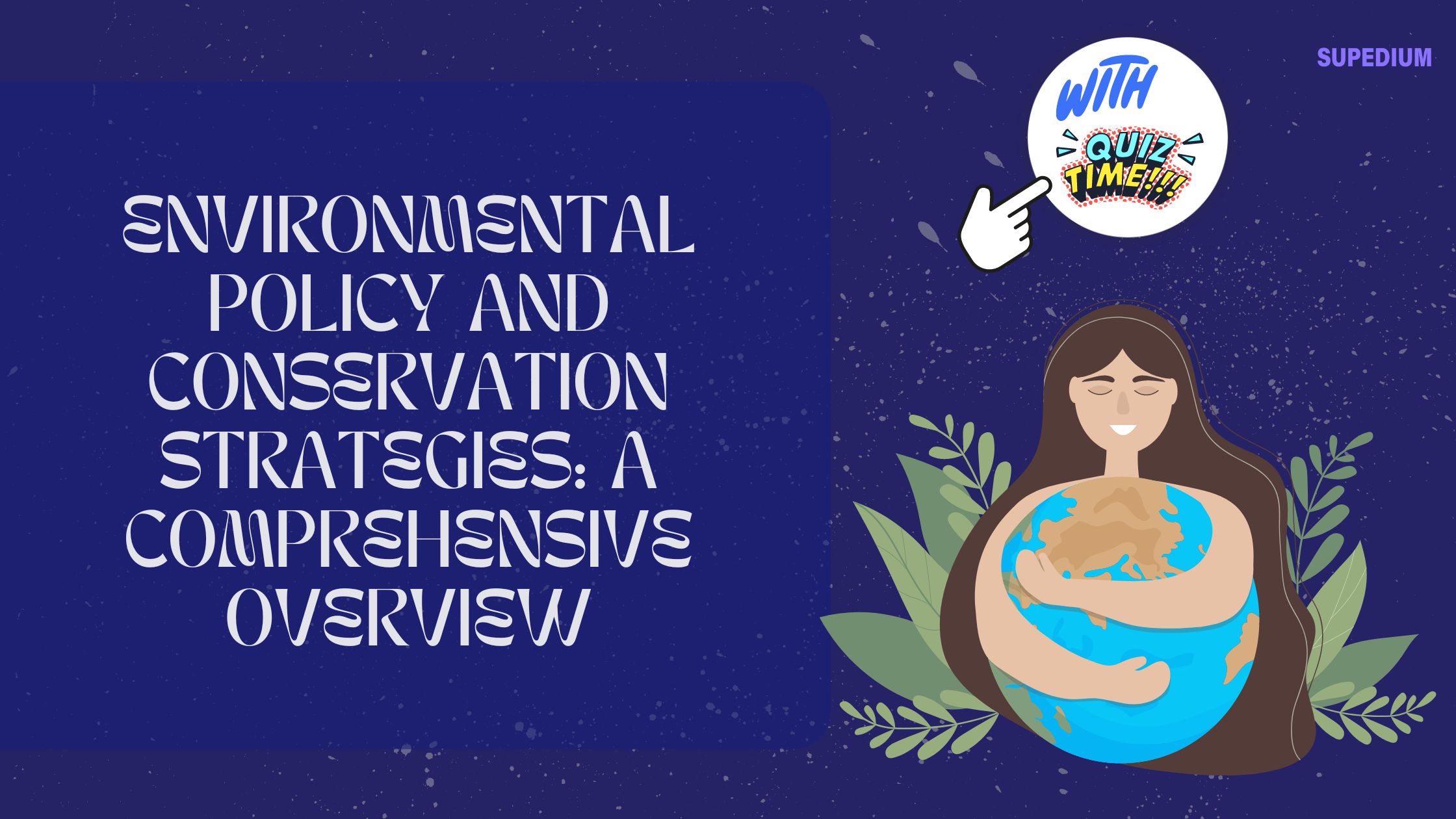Table of Contents
![]()
Introduction
Environmental Policy refers to a set of regulations and guidelines designed to protect and manage the environment. It encompasses a broad range of areas, including air and water quality, waste management, land use, and conservation. These policies aim to mitigate environmental degradation, preserve natural resources, and promote sustainable practices.
Conservation Strategies, on the other hand, involve various approaches and actions to safeguard natural resources and ecosystems. This includes practices aimed at sustainability, restoration efforts, and protection measures. Both environmental policies and conservation strategies are crucial for addressing pressing issues such as climate change, biodiversity loss, and resource depletion, while also ensuring the health and well-being of both ecosystems and human populations.
Historical Context
The roots of environmental policy and conservation strategies extend back to early human practices. Historically, many cultures had traditional methods for managing natural resources and protecting landscapes. For instance, Indigenous peoples often practiced sustainable hunting and agriculture, deeply intertwined with their cultural and spiritual values.
The modern environmental movement began to take shape in the 19th and early 20th centuries. Pioneering conservationists like John Muir and Theodore Roosevelt advocated for the protection of natural landscapes, leading to the establishment of national parks and protected areas. The 1960s and 1970s saw a surge in environmental awareness, marked by events such as Earth Day and the creation of the Environmental Protection Agency (EPA) in the United States.
Key international agreements like the Kyoto Protocol (1997) and the Paris Agreement (2015) represent significant milestones, reflecting a growing global commitment to address climate change and environmental degradation. Over time, conservation strategies have evolved from a focus on preservation to incorporating sustainable management practices, integrating scientific research, and adapting to new challenges.
Key Environmental Policies
National Policies:
- Clean Air Act (U.S.): Established in 1963 and significantly amended in 1970 and 1990, the Clean Air Act sets standards for air quality to protect public health and the environment. It has led to significant reductions in pollutants such as sulfur dioxide, nitrogen oxides, and particulate matter, improving air quality and public health.
- Clean Water Act (U.S.): Enacted in 1972, this policy regulates discharges of pollutants into U.S. waters and sets quality standards for surface waters. It has been instrumental in reducing pollution and improving water quality in rivers, lakes, and estuaries, though challenges remain in addressing nonpoint source pollution and emerging contaminants.
- Endangered Species Act (U.S.): This 1973 law aims to protect critically endangered species from extinction. It has led to the recovery of several species, including the bald eagle and the gray wolf, by providing legal protections and recovery plans.
International Agreements:
- United Nations Framework Convention on Climate Change (UNFCCC): Established in 1992, the UNFCCC provides a framework for international cooperation on climate change. Key agreements under this framework include the Kyoto Protocol, which set binding emission reduction targets for developed countries, and the Paris Agreement, which aims to limit global temperature rise to well below 2°C above pre-industrial levels.
- Convention on Biological Diversity (CBD): Adopted in 1992, the CBD aims to conserve biodiversity, promote sustainable use of its components, and ensure fair sharing of benefits arising from genetic resources. It encompasses a wide range of activities, including the establishment of protected areas and the promotion of sustainable practices.
Regional Policies:
- European Union Environmental Regulations: The EU has implemented various environmental policies, such as the EU Green Deal, which aims to make Europe the first climate-neutral continent by 2050. The Natura 2000 network, another significant initiative, consists of protected areas designated to conserve Europe’s most valuable habitats and species.
- National Policies within Regions: In Australia, for example, the Great Barrier Reef Marine Park Authority manages one of the world’s largest coral reef systems through policies aimed at protecting its biodiversity and mitigating the impacts of climate change and other threats.
Conservation Strategies
Protection and Preservation:
- Establishing Protected Areas: Protected areas such as national parks, wildlife reserves, and marine protected areas are crucial for safeguarding biodiversity and preserving ecosystems. They provide refuge for wildlife and help maintain ecological processes.
- Species Protection Programs: Programs aimed at protecting endangered species involve habitat protection, anti-poaching measures, and breeding programs. Successful examples include the recovery of the giant panda and the California condor.
Restoration and Rehabilitation:
- Habitat Restoration Projects: Restoration efforts focus on restoring degraded ecosystems to their natural state. Examples include wetland restoration projects, which enhance water filtration and provide habitat for wildlife, and reforestation initiatives aimed at reversing deforestation and improving carbon sequestration.
- Reforestation and Afforestation Efforts: Reforestation involves planting trees in deforested areas, while afforestation refers to planting trees in areas where there were no forests previously. Both strategies help combat climate change, restore biodiversity, and improve soil health.
Sustainable Practices:
- Sustainable Agriculture and Forestry: These practices aim to balance food production with environmental protection. Techniques such as agroforestry, organic farming, and sustainable logging help reduce environmental impacts and promote resource conservation.
- Responsible Consumption and Production: Reducing waste, recycling, and promoting sustainable consumption patterns are essential for minimizing the environmental footprint of human activities. This includes adopting circular economy principles and reducing reliance on single-use plastics.
- Renewable Energy Sources: Transitioning to renewable energy sources like solar, wind, and hydro power reduces greenhouse gas emissions and dependence on fossil fuels. Renewable energy technologies also offer economic opportunities and can enhance energy security.
Community and Indigenous Involvement:
- Indigenous Knowledge and Practices: Indigenous communities often have deep ecological knowledge and sustainable practices that contribute to conservation. Incorporating their perspectives and practices can enhance conservation outcomes and promote cultural preservation.
- Community-Based Conservation Initiatives: Engaging local communities in conservation efforts helps ensure that projects are relevant and effective. Community-based initiatives often focus on sustainable livelihoods, environmental education, and participatory management.
Technological Innovations:
- Remote Sensing and Monitoring: Advances in remote sensing technologies, such as satellites and drones, enable more effective monitoring of environmental changes and biodiversity. These tools help track deforestation, habitat loss, and other environmental impacts.
- Environmental Impact Assessments (EIAs): EIAs are used to evaluate the potential environmental impacts of proposed projects or policies. They help identify and mitigate negative effects, ensuring that development activities are environmentally sustainable.
- Green Technologies: Innovations in green technologies, such as energy-efficient appliances and pollution control technologies, contribute to environmental protection and resource conservation.
Challenges and Criticisms
Policy Implementation Issues:
- Enforcement and Compliance: Effective implementation of environmental policies often faces challenges related to enforcement and compliance. Limited resources, bureaucratic obstacles, and political resistance can undermine the effectiveness of regulations.
- Conflicting Interests and Political Hurdles: Balancing environmental goals with economic and political interests can be difficult. Conflicting priorities and vested interests may hinder the adoption of comprehensive policies.
Conservation Limitations:
- Funding and Resource Constraints: Conservation efforts often require substantial funding and resources. Limited financial support can impede the implementation of conservation projects and the maintenance of protected areas.
- Inadequate Scientific Data: Insufficient scientific data can hinder effective conservation planning and decision-making. Ongoing research and monitoring are essential for understanding ecosystems and addressing emerging threats.
Criticisms and Controversies:
- Over-Reliance on Market-Based Solutions: Some criticize market-based approaches, such as carbon trading, for failing to address the root causes of environmental issues. These solutions may also disproportionately affect vulnerable communities.
- Potential Negative Impacts on Local Communities: Conservation policies can sometimes lead to unintended negative impacts on local communities, such as displacement or restricted access to resources. Ensuring that conservation efforts are socially equitable is crucial.
Case Studies
Success Stories:
- Recovery of the Bald Eagle: Once on the brink of extinction due to habitat loss and pesticide use, the bald eagle has made a remarkable recovery thanks to the Endangered Species Act and focused conservation efforts.
- Reforestation of Costa Rica: Costa Rica has successfully reversed deforestation trends through reforestation programs, resulting in increased forest cover and biodiversity. The country’s commitment to conservation has also enhanced ecotourism and sustainable development.
Lessons Learned from Failures:
- Decline of the Cod Fishery: The collapse of the Atlantic cod fishery highlights the consequences of overfishing and inadequate management. It underscores the need for sustainable fisheries management and the importance of scientific research in guiding policy.
- Deforestation Issues in the Amazon Basin: Despite efforts to protect the Amazon, ongoing deforestation driven by agriculture and logging continues to threaten the region’s biodiversity and climate stability. Addressing these challenges requires strengthened policies and international cooperation.
Future Directions
Emerging Trends:
- Integration of Artificial Intelligence: AI and machine learning technologies are increasingly used in environmental monitoring and management. These tools can analyze large datasets, predict environmental changes, and optimize conservation strategies.
- Focus on Climate Justice and Equity: Future environmental policies are expected to place greater emphasis on climate justice, addressing the disproportionate impacts of environmental issues on vulnerable populations, and ensuring equitable access to resources.
Policy Innovations:
- Strengthening International Cooperation: Enhancing global collaboration and coordination is essential for addressing transboundary environmental issues such as climate change and biodiversity loss. International agreements and partnerships will play a critical role in achieving global conservation goals.
- Adapting Policies to Local Contexts: Tailoring environmental policies to local conditions and needs can improve their effectiveness. Engaging local stakeholders and incorporating local knowledge into policy design and implementation is crucial.
Role of Education and Advocacy:
- Public Awareness Campaigns: Increasing public awareness about environmental issues and conservation efforts can drive behavioral change and support for environmental policies. Educational programs and media campaigns play a key role in fostering environmental stewardship.
- Role of NGOs and Grassroots Movements: Non-governmental organizations (NGOs) and grassroots movements are instrumental in advocating for environmental protection, implementing conservation projects, and holding policymakers accountable.
Conclusion
Environmental policies and conservation strategies are integral to addressing the pressing challenges of climate change, biodiversity loss, and resource depletion. By understanding the historical context, key policies, and conservation approaches, as well as the challenges and innovations shaping the field, we can better navigate the complexities of environmental protection and work towards a sustainable future. Collaborative efforts, informed by science and guided by equity, will be essential in achieving long-term conservation goals and ensuring a healthy planet for future generations.






Be the first to comment